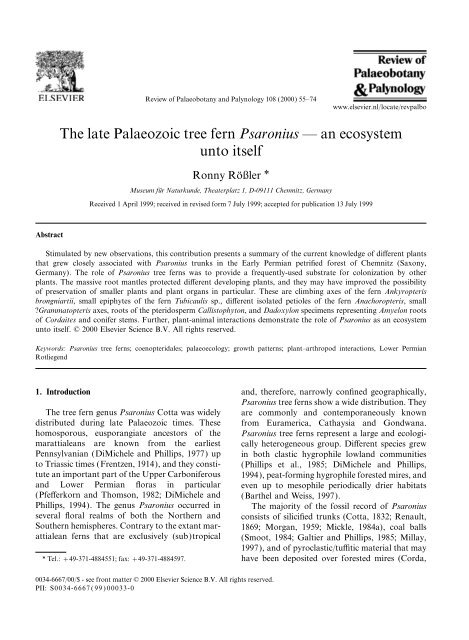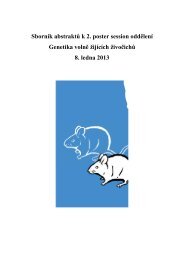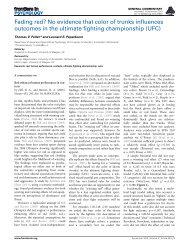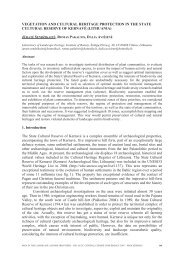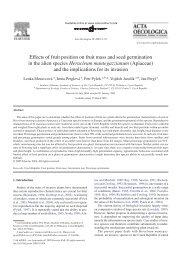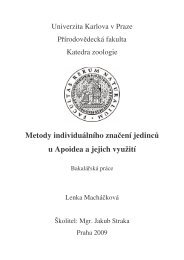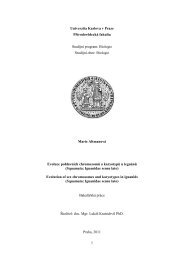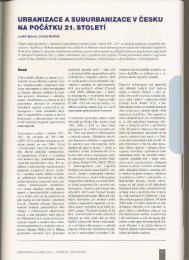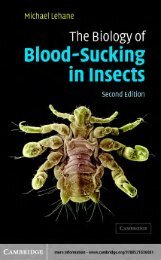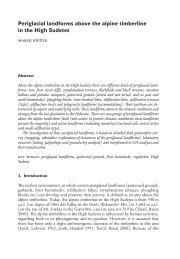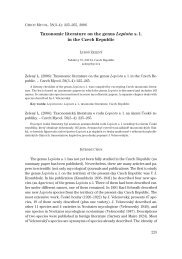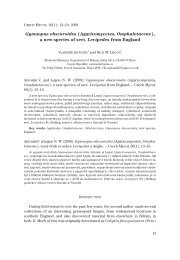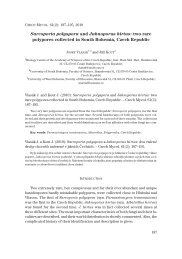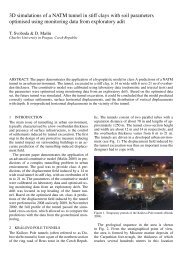The late Palaeozoic tree fern Psaronius — an ecosystem unto itself
The late Palaeozoic tree fern Psaronius — an ecosystem unto itself
The late Palaeozoic tree fern Psaronius — an ecosystem unto itself
Create successful ePaper yourself
Turn your PDF publications into a flip-book with our unique Google optimized e-Paper software.
Abstract<br />
Review of Palaeobot<strong>an</strong>y <strong>an</strong>d Palynology 108 (2000) 55–74<br />
www.elsevier.nl/locate/revpalbo<br />
<strong>The</strong> <strong>late</strong> <strong>Palaeozoic</strong> <strong>tree</strong> <strong>fern</strong> <strong>Psaronius</strong> <strong>—</strong> <strong>an</strong> <strong>ecosystem</strong><br />
<strong>unto</strong> <strong>itself</strong><br />
Ronny Rößler *<br />
Museum für Naturkunde, <strong>The</strong>aterplatz 1, D-09111 Chemnitz, Germ<strong>an</strong>y<br />
Received 1 April 1999; received in revised form 7 July 1999; accepted for publication 13 July 1999<br />
Stimu<strong>late</strong>d by new observations, this contribution presents a summary of the current knowledge of different pl<strong>an</strong>ts<br />
that grew closely associated with <strong>Psaronius</strong> trunks in the Early Permi<strong>an</strong> petrified forest of Chemnitz (Saxony,<br />
Germ<strong>an</strong>y). <strong>The</strong> role of <strong>Psaronius</strong> <strong>tree</strong> <strong>fern</strong>s was to provide a frequently-used substrate for colonization by other<br />
pl<strong>an</strong>ts. <strong>The</strong> massive root m<strong>an</strong>tles protected different developing pl<strong>an</strong>ts, <strong>an</strong>d they may have improved the possibility<br />
of preservation of smaller pl<strong>an</strong>ts <strong>an</strong>d pl<strong>an</strong>t org<strong>an</strong>s in particular. <strong>The</strong>se are climbing axes of the <strong>fern</strong> Ankyropteris<br />
brongniartii, small epiphytes of the <strong>fern</strong> Tubicaulis sp., different iso<strong>late</strong>d petioles of the <strong>fern</strong> Anachoropteris, small<br />
?Grammatopteris axes, roots of the pteridosperm Callistophyton, <strong>an</strong>d Dadoxylon specimens representing Amyelon roots<br />
of Cordaites <strong>an</strong>d conifer stems. Further, pl<strong>an</strong>t-<strong>an</strong>imal interactions demonstrate the role of <strong>Psaronius</strong> as <strong>an</strong> <strong>ecosystem</strong><br />
<strong>unto</strong> <strong>itself</strong>. © 2000 Elsevier Science B.V. All rights reserved.<br />
Keywords: <strong>Psaronius</strong> <strong>tree</strong> <strong>fern</strong>s; coenopteridales; palaeoecology; growth patterns; pl<strong>an</strong>t–arthropod interactions, Lower Permi<strong>an</strong><br />
Rotliegend<br />
1. Introduction <strong>an</strong>d, therefore, narrowly confined geographically,<br />
<strong>Psaronius</strong> <strong>tree</strong> <strong>fern</strong>s show a wide distribution. <strong>The</strong>y<br />
<strong>The</strong> <strong>tree</strong> <strong>fern</strong> genus <strong>Psaronius</strong> Cotta was widely are commonly <strong>an</strong>d contempor<strong>an</strong>eously known<br />
distributed during <strong>late</strong> <strong>Palaeozoic</strong> times. <strong>The</strong>se from Euramerica, Cathaysia <strong>an</strong>d Gondw<strong>an</strong>a.<br />
homosporous, euspor<strong>an</strong>giate <strong>an</strong>cestors of the <strong>Psaronius</strong> <strong>tree</strong> <strong>fern</strong>s represent a large <strong>an</strong>d ecologimarattiale<strong>an</strong>s<br />
are known from the earliest cally heterogeneous group. Different species grew<br />
Pennsylv<strong>an</strong>i<strong>an</strong> (DiMichele <strong>an</strong>d Phillips, 1977) up in both clastic hygrophile lowl<strong>an</strong>d communities<br />
to Triassic times (Frentzen, 1914), <strong>an</strong>d they consti- (Phillips et al., 1985; DiMichele <strong>an</strong>d Phillips,<br />
tute <strong>an</strong> import<strong>an</strong>t part of the Upper Carboniferous 1994), peat-forming hygrophile forested mires, <strong>an</strong>d<br />
<strong>an</strong>d Lower Permi<strong>an</strong> floras in particular even up to mesophile periodically drier habitats<br />
(Pfefferkorn <strong>an</strong>d Thomson, 1982; DiMichele <strong>an</strong>d (Barthel <strong>an</strong>d Weiss, 1997).<br />
Phillips, 1994). <strong>The</strong> genus <strong>Psaronius</strong> occurred in <strong>The</strong> majority of the fossil record of <strong>Psaronius</strong><br />
several floral realms of both the Northern <strong>an</strong>d consists of silicified trunks (Cotta, 1832; Renault,<br />
Southern hemispheres. Contrary to the ext<strong>an</strong>t mar- 1869; Morg<strong>an</strong>, 1959; Mickle, 1984a), coal balls<br />
attiale<strong>an</strong> <strong>fern</strong>s that are exclusively (sub)tropical (Smoot, 1984; Galtier <strong>an</strong>d Phillips, 1985; Millay,<br />
1997), <strong>an</strong>d of pyroclastic/tuffitic material that may<br />
* Tel.: +49-371-4884551; fax: +49-371-4884597. have been deposited over forested mires (Corda,<br />
0034-6667/00/$ - see front matter © 2000 Elsevier Science B.V. All rights reserved.<br />
PII: S0034-6667(99)00033-0
56 R. Rößler / Review of Palaeobot<strong>an</strong>y <strong>an</strong>d Palynology 108 (2000) 55–74<br />
1845; Rößler <strong>an</strong>d Barthel, 1998). <strong>The</strong> research noteworthy role in preserving the different, some-<br />
history of <strong>Psaronius</strong> reaches back to the early days times delicate, pl<strong>an</strong>t org<strong>an</strong>s during various clastic<br />
of palaeobot<strong>an</strong>y (Sprengel, 1828; Cotta, 1832; <strong>an</strong>d volc<strong>an</strong>ic fossilization processes. In most cases,<br />
Corda, 1845; Stenzel, 1854). In more recent years axes, petioles <strong>an</strong>d roots of other pl<strong>an</strong>ts were found<br />
Morg<strong>an</strong> (1959), Stidd <strong>an</strong>d Phillips (1968), Stidd within the outer root m<strong>an</strong>tle (free root zone) of<br />
(1971), Ehret <strong>an</strong>d Phillips (1977), <strong>an</strong>d Mickle the <strong>Psaronius</strong> trunks. <strong>The</strong>y are firmly <strong>an</strong>chored<br />
(1984a,b) provided valuable new information on aided by their own adventitious roots. Only a few<br />
the genus.<br />
examples (P<strong>late</strong> II, 1) show remains of free-grow-<br />
<strong>The</strong> aim of this contribution is to present new ing climbers on the surface of <strong>Psaronius</strong>, possibly<br />
observations on material from the petrified forest<br />
of Chemnitz, <strong>an</strong>d to integrate long-known, iso<strong>late</strong>d<br />
data on different pl<strong>an</strong>ts or pl<strong>an</strong>t org<strong>an</strong>s that grew<br />
on <strong>Psaronius</strong> trunks or embedded in the <strong>Psaronius</strong><br />
at positions higher up on the trunk.<br />
free root zone, more or less hidden below the<br />
surface. <strong>The</strong>re is a considerable number of pl<strong>an</strong>t–<br />
2. Materials <strong>an</strong>d methods<br />
pl<strong>an</strong>t or pl<strong>an</strong>t–<strong>an</strong>imal interactions worth focusing <strong>The</strong> material studied, described <strong>an</strong>d illustrated<br />
on in light of new evidence, which comes mainly in this contribution comes from the Permi<strong>an</strong> petri-<br />
from the Permi<strong>an</strong> of Chemnitz. fied forest of Chemnitz, the type locality of<br />
To date we know of several taxa belonging to <strong>Psaronius</strong>. <strong>The</strong> pl<strong>an</strong>t-bearing layer was found at<br />
different systematic groups r<strong>an</strong>ging from zygopt- the base of the Zeisigwald tuff horizon<br />
erid <strong>fern</strong>s (Galtier <strong>an</strong>d Phillips, 1996) <strong>an</strong>d sphenop- (Leukersdorf Formation, Erzgebirge Basin, eastern<br />
sids up to gymnosperms that grew on the Germ<strong>an</strong>y). This pyroclastic sequence was depos-<br />
(sub)surface of <strong>Psaronius</strong>, including vines, epiited during several phreatomagmatic-influenced<br />
phytes <strong>an</strong>d even scrambling shrubby pl<strong>an</strong>ts. <strong>The</strong> volc<strong>an</strong>ic eruptions of the Zeisigwald volc<strong>an</strong>o that<br />
upright <strong>Psaronius</strong>-stems, especially their lower was responsible for incorporating <strong>an</strong>d preserving<br />
parts with thick m<strong>an</strong>tles of adventitious roots, a rich Permi<strong>an</strong> pl<strong>an</strong>t community (Fischer, 1990;<br />
apparently formed <strong>an</strong> ideal host for other pl<strong>an</strong>ts. Rößler, 1995, 1996). Specimens under study are<br />
<strong>The</strong> large root m<strong>an</strong>tle firstly offered mech<strong>an</strong>ical stored in the following collections:<br />
support, <strong>an</strong>d secondly it may have protected the MfNC <strong>—</strong> Museum für Naturkunde, Chemnitz<br />
development of such pl<strong>an</strong>ts. Renault (1869) <strong>an</strong>d MMG <strong>—</strong> Museum für Mineralogie und<br />
Stenzel (1889) have already reported examples of Geologie, Dresden<br />
multiple pl<strong>an</strong>t-to-pl<strong>an</strong>t interaction in the fossil BAF <strong>—</strong> Freiberg University of Mining <strong>an</strong>d<br />
record. New examples allow us to recognize a Technology, Geological Institute.<br />
much greater diversity of pl<strong>an</strong>t life strategies on Specimens are preserved as siliceous cellular per-<br />
<strong>Psaronius</strong> <strong>an</strong>d permit reinterpretation of all exammineralizations. <strong>The</strong>y were examined from<br />
ples in the light of pl<strong>an</strong>t interactions within a small ground/polished surfaces <strong>an</strong>d thin sections, <strong>an</strong>d<br />
Permi<strong>an</strong> hygrophile community.<br />
subsequently observed/photographed under<br />
<strong>The</strong> current investigation focuses on the climb- reflected light using a Zeiss SV 11 binocular<br />
ing axes of Ankyropteris brongniartii, small microscope.<br />
Tubicaulis sp. epiphytes, iso<strong>late</strong>d Anachoropteris For comparative purposes, the Bolsovi<strong>an</strong> age<br />
petioles, ?Grammatopteris axes, Callistophyton type material of Anachoropteris Corda, stored at<br />
roots, <strong>an</strong>d Dadoxylon axes representing both the palaeobot<strong>an</strong>ical collection, National Museum,<br />
Amyelon roots of Cordaites <strong>an</strong>d conifer stems Prague, Czech Republic, <strong>an</strong>d the Permi<strong>an</strong> age type<br />
growing closely associated with <strong>Psaronius</strong> trunks. material of Tubicaulis Cotta, <strong>Psaronius</strong> Cotta, <strong>an</strong>d<br />
Records of the genera Anachoropteris <strong>an</strong>d Grammatopteris baldaufii (Beck) Hirmer, housed<br />
Callistophyton from Chemnitz are presented for in the palaeontological collection of the Freiberg<br />
the first time.<br />
University of Mining <strong>an</strong>d Technology, Freiberg,<br />
Finally, the root m<strong>an</strong>tle may have played a Germ<strong>an</strong>y, were additionally examined.
R. Rößler / Review of Palaeobot<strong>an</strong>y <strong>an</strong>d Palynology 108 (2000) 55–74<br />
3. Observations, descriptions <strong>an</strong>d discussion trunks were not frequently mentioned. For that<br />
reason it seems curious that the material, on which<br />
3.1. <strong>The</strong> genus <strong>Psaronius</strong> Cotta 1832 Cotta (1832) erected the genus <strong>Psaronius</strong>, showed<br />
several climbing axes of Ankyropteris brongniartii<br />
Although <strong>Psaronius</strong> material is to be found in growing in between the root m<strong>an</strong>tle. However, this<br />
m<strong>an</strong>y palaeobot<strong>an</strong>ical collections, a revision of the was not noted until Sterzel (1887) re-examined the<br />
genus is still lacking. <strong>The</strong> genus <strong>Psaronius</strong>, origi- largest known <strong>Psaronius</strong> specimen, <strong>an</strong>d compared<br />
nally introduced by Cotta (1832) for permineral- it with Cotta’s type specimen. Since that time a<br />
ized trunk segments, is used today to refer to the lot of <strong>an</strong>atomical work has been done <strong>an</strong>d, conseentire<br />
pl<strong>an</strong>t. <strong>Psaronius</strong> is considered as having<br />
upright, unbr<strong>an</strong>ched stems that reach a basal diameter<br />
of more th<strong>an</strong> 80 cm (Sterzel, 1887). <strong>The</strong> largest<br />
<strong>Psaronius</strong> specimen known so far (<strong>Psaronius</strong> weberi<br />
Sterzel, 1887; MfNC K 620), measures 80 cm in<br />
diameter, but the extreme asymmetry of the trunk,<br />
interpreted as taphonomic (see Rößler, 1996), may<br />
allow basal diameters up to 1.5 m to be predicted.<br />
<strong>The</strong> stem increases in size <strong>an</strong>d stelar complexity<br />
towards the crown, which carried large tri- to<br />
quadripinnate fronds. This obconical construction<br />
develops from a small siphonostele at the base of<br />
the trunk exp<strong>an</strong>ding upward to a polycyclic dicty-<br />
ostele at the apex (Morg<strong>an</strong>, 1959; Stidd <strong>an</strong>d<br />
Phillips, 1968). A dense m<strong>an</strong>tle of adventitious<br />
aerial roots, which show <strong>an</strong> actinostelic tracheidal<br />
bundle embedded in parenchymatous, sometimes<br />
aerenchymatous, ground tissue, supports the false<br />
stem. An inner bound zone (inner root m<strong>an</strong>tle)<br />
composed of smaller roots of regular spherical to<br />
elliptical shape is characterized by the appear<strong>an</strong>ce<br />
of secondarily derived parenchyma. <strong>The</strong> outer free<br />
zone (outer root m<strong>an</strong>tle) shows larger roots of<br />
different shape free of parenchyma (Ehret <strong>an</strong>d<br />
Phillips, 1977). <strong>The</strong> large fronds are normally three<br />
to four times pinnate, bi<strong>late</strong>rally symmetrical, <strong>an</strong>d<br />
reach a length of up to 3 m. <strong>The</strong>y had pecopterid-<br />
type pinnules. <strong>The</strong> arr<strong>an</strong>gement of leaf traces varies<br />
from two vertical rows up to spiral sequence.<br />
Petioles have C-shaped adaxially opened vascular<br />
traces. Fertile frond portions exhibit some different<br />
syn<strong>an</strong>giate types found on the abaxial surface of<br />
quently, a variety of examples showing other pl<strong>an</strong>ts<br />
growing on <strong>Psaronius</strong> trunks have been mentioned<br />
in the literature (Strauß, 1920; Sahni, 1931, 1935;<br />
Mamay, 1952; Urb<strong>an</strong>, 1974; Mickle, 1984a;<br />
Rothwell, 1991).<br />
<strong>The</strong> large root zone of <strong>Psaronius</strong> trunks may<br />
have provided a frequently used substrate that<br />
guar<strong>an</strong>teed safe development of juvenile epiphytes,<br />
<strong>an</strong>d offered mech<strong>an</strong>ical support for the frond-<br />
bearing adults. Our developing knowledge reveals<br />
<strong>an</strong> increasing number of pl<strong>an</strong>ts that were able to<br />
use these possibilities. Mickle (1984a) figured a<br />
triarch protostele belonging to Sphenophyllum<br />
Brongniart preserved among the adventitious roots<br />
of <strong>Psaronius</strong>. Rothwell (1991) reconstructed<br />
Botryopteris forensis Renault as <strong>an</strong> epiphyte on a<br />
<strong>Psaronius</strong> trunk. Recently there has been a growing<br />
awareness of alternative growth patterns among<br />
<strong>fern</strong>s or pteridosperms in Late <strong>Palaeozoic</strong> eco-<br />
systems (Behrensmeyer <strong>an</strong>d Hook, 1992). Indirect<br />
evidence of a li<strong>an</strong>a-like pl<strong>an</strong>t was shown by<br />
Gradzinski <strong>an</strong>d Doktor (1995), who figured <strong>an</strong><br />
upright Sigillaria trunk with <strong>an</strong> imprint of a wind-<br />
ing axis on its surface, from the lower Westphali<strong>an</strong><br />
of Upper Silesia, Pol<strong>an</strong>d. Kerp <strong>an</strong>d Krings (1998)<br />
reported three basically different types of climbing<br />
org<strong>an</strong>s on Late Carboniferous pteridosperms from<br />
the Bl<strong>an</strong>zy-Montceau Basin, Fr<strong>an</strong>ce, on the basis<br />
of cuticular material.<br />
Observations of different pl<strong>an</strong>t interactions on<br />
ext<strong>an</strong>t <strong>tree</strong> <strong>fern</strong>s show us the variety of life strate-<br />
pecopterid pinnules. <strong>The</strong> most familiar genus is gies among small <strong>fern</strong>s, which exist on <strong>tree</strong> <strong>fern</strong><br />
Scolecopteris Zenker (Millay, 1979; Barthel <strong>an</strong>d trunks, <strong>an</strong>d facilitate the reconstruction of growth<br />
Weiss, 1997).<br />
patterns <strong>an</strong>d life strategies of <strong>Palaeozoic</strong> <strong>fern</strong>s.<br />
Metaphorical descriptions by Christ (1910) repre-<br />
3.2. Pl<strong>an</strong>t interactions with <strong>Psaronius</strong> trunks<br />
sent <strong>an</strong> outst<strong>an</strong>ding guide to <strong>tree</strong> <strong>fern</strong>s, such as<br />
species of well-known Dicksonia, Cyathea or<br />
Although m<strong>an</strong>y examined <strong>Psaronius</strong> specimens Alsophila, as substrates for colonization by other<br />
exist, pl<strong>an</strong>ts or pl<strong>an</strong>t org<strong>an</strong>s growing on <strong>Psaronius</strong> pl<strong>an</strong>ts: ‘‘Eine g<strong>an</strong>z besondere Zierde älterer<br />
57
58 R. Rößler / Review of Palaeobot<strong>an</strong>y <strong>an</strong>d Palynology 108 (2000) 55–74<br />
PLATE I
R. Rößler / Review of Palaeobot<strong>an</strong>y <strong>an</strong>d Palynology 108 (2000) 55–74<br />
Farnstämme sind die Luftwurzeln, welche am (Podkrkonose Basin, Czech Republic). In almost<br />
Stamm in dichter Fülle hervorbrechen, zur Erde all occurrences of the pl<strong>an</strong>t in the Permi<strong>an</strong> it was<br />
herabsteigen und ihn mit einem festen Geflecht found climbing within <strong>Psaronius</strong> root m<strong>an</strong>tles or<br />
umgeben, das einer Schar zierlichster Epiphyten on their surfaces (P<strong>late</strong> II, 1–4). <strong>The</strong> most conspic-<br />
als Zuflucht dient’’. Several Hymenophyllum, uous characters of this pl<strong>an</strong>t are the presence of<br />
Asplenium, Polypodium, Davallia <strong>an</strong>d Trichom<strong>an</strong>es axillary br<strong>an</strong>ching, which is frequently seen, <strong>an</strong>d<br />
<strong>fern</strong> species showing epiphytic growth were the dense overlapping vascularized aphlebiae<br />
reported from northern New Zeal<strong>an</strong>d, Costa Rica, covering the climbing axis. Comparisons of this<br />
Brazil <strong>an</strong>d Teneriffa Isl<strong>an</strong>d (Christ, 1910). vine-like pl<strong>an</strong>t with vegetative structures of<br />
Impressive li<strong>an</strong>a-like climbers among ext<strong>an</strong>t <strong>fern</strong>s Senftenbergia (Jennings <strong>an</strong>d Eggert, 1977) seem to<br />
include species of Polypodium, Drynaria, be confirmed by specimens obtained from a Lower<br />
Stenochlaena <strong>an</strong>d Ole<strong>an</strong>dra.<br />
Permi<strong>an</strong> crystal tuff horizon of the Döhlen Basin,<br />
Several examples of pl<strong>an</strong>t interactions involving eastern Germ<strong>an</strong>y (Rößler <strong>an</strong>d Barthel, 1998: pl.<br />
Permi<strong>an</strong> <strong>Psaronius</strong> <strong>tree</strong> <strong>fern</strong>s may be demonstrated 6, 2). <strong>The</strong> A. brongniartii vines are not only<br />
as follows. reported as growing on <strong>Psaronius</strong>. From Chemnitz,<br />
A. brongniartii was noted as growing on a calamite<br />
3.2.1. <strong>Psaronius</strong>–<strong>Psaronius</strong><br />
stem (Calamodendron striatum Cotta, unpublished<br />
A first, <strong>an</strong>d unusual, example of <strong>tree</strong>-<strong>fern</strong> inter- observation), favouring the reconstruction of that<br />
actions is <strong>an</strong> intraspecific one. Sometimes, two calamite by Remy <strong>an</strong>d Remy (1978) against that<br />
<strong>Psaronius</strong> individuals may have grown as close of Hirmer (1927).<br />
together (P<strong>late</strong> I, 2). This resulted in dense penet- Some of the Chemnitz specimens of<br />
ration of the downward growing free roots forming Ankyropteris brongniartii display a delicate exam-<br />
a single m<strong>an</strong>tle of free adventitious roots, which ple of pl<strong>an</strong>t–<strong>an</strong>imal interactions (see also below).<br />
contains two axes each independently surrounded Within stem or petiole parenchyma (mostly around<br />
by its own dense inner root m<strong>an</strong>tle (P<strong>late</strong> I, 1). the phloem tissue) there are small hollows densely<br />
<strong>The</strong>re is no indication as to whether the two filled up with arthropod coprolites (P<strong>late</strong> 7, 1–5).<br />
examples shown represent bifurcating axes of one <strong>The</strong>se are egg-like spherical to slightly elongated<br />
<strong>tree</strong>. bodies of two distinct sizes. This feature is also<br />
clearly seen in some figures of Mickle (1980: figs.<br />
3.2.2. <strong>Psaronius</strong>–Ankyropteris<br />
12, 13, 15, 16) <strong>an</strong>d Smoot (1985: fig. 27) involving<br />
Ankyropteris is <strong>an</strong> extinct genus of zygopterid North Americ<strong>an</strong> coal ball specimens of A. brongni-<br />
<strong>fern</strong> that exhibits a five to six-lobed medullose artii, although it was not mentioned by the authors.<br />
actinostele <strong>an</strong>d H-shaped petiolar xylem<br />
(Bertr<strong>an</strong>d, 1907; Mickle, 1980). This taxon proba- 3.2.3. <strong>Psaronius</strong>–Tubicaulis<br />
bly provides the earliest evidence of pl<strong>an</strong>ts growing Tubicaulis was established by Cotta (1832) to<br />
on <strong>Psaronius</strong> trunks. <strong>The</strong> type species, Ankyropteris accommodate exarch protostelic stems with a<br />
brongniartii (Renault, 1869) Mickle from the C-shaped petiolar xylem. Among the Tubicaulis<br />
Lower Permi<strong>an</strong> of Fr<strong>an</strong>ce, is very frequent at species known to date, there are different stelar<br />
Chemnitz <strong>an</strong>d also is known from Nova Paka types that produced the same type of petiole. This<br />
PLATE I<br />
1. Two distichous stems of <strong>Psaronius</strong> cottae Corda within a single outer root m<strong>an</strong>tle, MfNC K 4561, ×0.5.<br />
2. Two distichous <strong>Psaronius</strong> stems within a small single root m<strong>an</strong>tle, MfNC K 4562.<br />
3. Amyelon root of Cordaites preserved in close association with a basal <strong>Psaronius</strong> trunk, MfNC K 4561.<br />
4. Preservational proximity of a gymnospermous stem preserved by a fragment of thick secondary xylem to the root m<strong>an</strong>tle of<br />
<strong>Psaronius</strong>, MfNC K 669.<br />
59
60 R. Rößler / Review of Palaeobot<strong>an</strong>y <strong>an</strong>d Palynology 108 (2000) 55–74<br />
PLATE II
R. Rößler / Review of Palaeobot<strong>an</strong>y <strong>an</strong>d Palynology 108 (2000) 55–74<br />
very artificial genus may represent at least two P<strong>late</strong> III, 1–4 IV, 1–7). <strong>The</strong>se allow us to recognize<br />
different evolutionary lines from the Lower some more Tubicaulis pl<strong>an</strong>ts as true trunk epi-<br />
L<strong>an</strong>gsetti<strong>an</strong> to the Permi<strong>an</strong>, each of which exhibits phytes, <strong>an</strong>d to confirm the observation of<br />
the same variability in size, internal <strong>an</strong>atomy <strong>an</strong>d Mamay (1952).<br />
growth habit (Phillips, 1974). <strong>The</strong> type specimen, <strong>The</strong> slender sometimes br<strong>an</strong>ched axes show a<br />
Tubicaulis solenites Cotta from Flöha near thickness of between 15 <strong>an</strong>d 35 mm. <strong>The</strong> central<br />
Chemnitz, represents a small free-growing <strong>tree</strong> <strong>fern</strong> solid protostele measures 2.3 to 6.5 mm, <strong>an</strong>d is<br />
<strong>an</strong>d, along with T. sutcliffii Stopes, may have had encircled by cortical parenchyma up to 12 mm<br />
<strong>an</strong> unbr<strong>an</strong>ched erect axis with a solid protostele wide. <strong>The</strong> vascular system is a simple tracheidal<br />
<strong>an</strong>d multiseriate circular bordered metaxylem pit- mass, <strong>an</strong>d shows exarch maturation of the prototing.<br />
<strong>The</strong> other line of the genus shows vitalized xylem groups. <strong>The</strong> surrounding cortical paren-<br />
(mixed) protosteles <strong>an</strong>d multiseriate scalariform chyma consists of isodiametric cells with thin walls.<br />
metaxylem pitting, represented by T. stewartii Further, r<strong>an</strong>domly distributed discrete patches of<br />
(Eggert, 1959), T. multiscalariformis (Delevoryas dark-brown to black thick-walled cells could be<br />
<strong>an</strong>d Morg<strong>an</strong>, 1952) <strong>an</strong>d T. afric<strong>an</strong>us (Holden <strong>an</strong>d observed (P<strong>late</strong> III, 2, 3; P<strong>late</strong> IV, 3, 7). <strong>The</strong>y may<br />
Croft, 1962). <strong>The</strong> latter group exhibits intercon- represent sclerotic nests. Leaf traces are spirally<br />
nections between Tubicaulis <strong>an</strong>d Anachoropteris arr<strong>an</strong>ged in a 2/5 phyllotaxy. Axillary br<strong>an</strong>ching,<br />
involuta-petioles, as was first demonstrated by Hall as noted for the first time by Galtier <strong>an</strong>d Holmes<br />
(1961). Phillips (1974) also reported small (1984), is very commonly seen. Numerous adventi-<br />
Tubicaulis shoots borne on Anachoropteris. This tious roots could be traced at the periphery of the<br />
was confirmed by Galtier <strong>an</strong>d Holmes (1984: pl. axes. <strong>The</strong>y have the typical coenopterid diarch<br />
2) studying material from Gr<strong>an</strong>d Croix, Fr<strong>an</strong>ce, xylem str<strong>an</strong>ds surrounded by the cortex, <strong>an</strong>d<br />
that resembled T. stewartii Eggert from the Upper dichotomize in their downward course.<br />
Pennsylv<strong>an</strong>i<strong>an</strong> of Illinois.<br />
Bertr<strong>an</strong>d (1909) was first drawn to epiphytic<br />
Several examples from the fossil record, how- Tubicaulis specimens after studying the Chemnitz<br />
ever, exhibit small slender rhizomatous pl<strong>an</strong>ts material. Later, Bertr<strong>an</strong>d <strong>an</strong>d Bertr<strong>an</strong>d (1911)<br />
growing as epiphytes that probably found ideal established Tubicaulis berthieri for a single speci-<br />
conditions for mech<strong>an</strong>ical support among adventimen from the Permi<strong>an</strong> of Autun, Fr<strong>an</strong>ce. Sahni<br />
tious roots on <strong>Psaronius</strong> trunks. Noted features (1931) reported epiphytic specimens of Tubicaulis<br />
are characteristic for Tubicaulis sc<strong>an</strong>dens Mamay, from Chemnitz, <strong>an</strong>d he confirmed the noteworthy<br />
for inst<strong>an</strong>ce, based on one single coal ball specimen frequency of these pl<strong>an</strong>ts. He mentioned one speci-<br />
from the Upper Pennsylv<strong>an</strong>i<strong>an</strong> of Illinois. men with seven Tubicaulis axes from Chemnitz. I<br />
Comparable epiphytic growth habit on a <strong>Psaronius</strong> believe that this import<strong>an</strong>t specimen, although<br />
trunk was recently reported for Botryopteris never described in detail or figured, was recently<br />
forensis (Rothwell, 1991). traced in the collection of the Museum für<br />
More th<strong>an</strong> 40 Tubicaulis shoots penetrating the Naturkunde Chemnitz (MfNC K 3475, P<strong>late</strong> IV,<br />
free root zone of <strong>Psaronius</strong> were newly discovered 1–7). Sahni (1935) focused on one more Chemnitz<br />
from the Permi<strong>an</strong> of Chemnitz (P<strong>late</strong> II, 3; specimen showing several Ankyropteris axes <strong>an</strong>d<br />
PLATE II<br />
1. Bifurcating axes <strong>an</strong>d petiole traces of Ankyropteris brongniartii on the upper part surface of a <strong>Psaronius</strong> trunk, MfNC K<br />
228, ×0.5.<br />
2. <strong>Psaronius</strong> trunk showing eight Ankyropteris. brongniartii axes on the periphery of the outer root m<strong>an</strong>tle MfNC K 228, ×0.25.<br />
3. Cross-section of a <strong>Psaronius</strong> trunk containing four Ankyropteris brongniartii axes <strong>an</strong>d one Tubicaulis sp. on the left margin,<br />
counterpart of the specimen drawn by Sahni (1935, fig. 1), MfNC K 2.<br />
4. Cross-section of a <strong>Psaronius</strong> trunk containing one Tubicaulis sp. axis (big arrow) <strong>an</strong>d three Ankyropteris brongniartii axes<br />
(small arrows), MfNC K 31.<br />
61
62 R. Rößler / Review of Palaeobot<strong>an</strong>y <strong>an</strong>d Palynology 108 (2000) 55–74<br />
PLATE III
R. Rößler / Review of Palaeobot<strong>an</strong>y <strong>an</strong>d Palynology 108 (2000) 55–74<br />
one Tubicaulis, which he received from Max (P<strong>late</strong> IV, 2) is the same as the one that was reported,<br />
Güldner, a local private collector. During the but not described or figured, by Sahni (1931).<br />
present investigation, the counterpart of this speci- Specimen MMG SaP 1900 (P<strong>late</strong> V, 2, 3 two<br />
men (MfNC K 2, P<strong>late</strong> II, 3) was found in the small <strong>an</strong>achoropterid petioles. <strong>The</strong> first measures<br />
Chemnitz collection. Most of the newly discovered 6.3 mm in diameter with a 4.1 mm×2.5 mm wide<br />
material exhibits coexistence of these two genera vascular str<strong>an</strong>d <strong>an</strong>d several adaxially located<br />
on the same <strong>tree</strong> <strong>fern</strong> trunk. Although it seems protoxylem groups. <strong>The</strong> second measures 3.5 mm<br />
obvious that the Tubicaulis-axes were frequent in diameter with a 2.0 mm×1.4 mm wide vascular<br />
epiphytes on <strong>Psaronius</strong> trunks, it still remains str<strong>an</strong>d. Because of the typical inrolled vascular<br />
unclear which sterile/fertile frond type belongs to str<strong>an</strong>d, it may be identified as Anachoropteris<br />
Tubicaulis <strong>fern</strong>s <strong>an</strong>d what the entire pl<strong>an</strong>ts pulchra Corda. After comparisons with material<br />
looked like.<br />
of the Corda-collection stored in Prague, Czech<br />
Republic, the species A. involuta Hoskins is<br />
3.2.4. <strong>Psaronius</strong>–Anachoropteris<br />
regarded as synonymous with the latter. A separate<br />
Anachoropteris is <strong>an</strong> org<strong>an</strong> genus that was species seems unjustified from the current point of<br />
instituted by Corda (1845) for iso<strong>late</strong>d petioles view, because the description presented by Hoskins<br />
exhibiting a U-shaped to inrolled vascular str<strong>an</strong>d (1930) does not note <strong>an</strong>y clear differences.<br />
with abaxially located protoxylem groups. Although the new Chemnitz specimen exhibits two<br />
Consequently, it represents the petiole of a hetero- Tubicaulis axes, no direct connection between both<br />
geneous group of <strong>fern</strong>s, <strong>an</strong>d it is characterized by org<strong>an</strong>s, as shown by Hall (1961) <strong>an</strong>d Galtier <strong>an</strong>d<br />
diversity in size, br<strong>an</strong>ching pattern <strong>an</strong>d growth<br />
habit.<br />
Holmes (1984) for ‘A. involuta’, could be identified.<br />
Until now there is multiple evidence of 3.2.5. <strong>Psaronius</strong>–?Grammatopteris<br />
Anachoropteris petioles growing close to <strong>Psaronius</strong> Specimen SaP 1900 (MMG Dresden) exhibits a<br />
trunks (Sahni, 1931; Mickle, 1984a: fig. 46; small slightly lobed solid protostele of 3.8 mm<br />
Doubinger et al., 1995: fig. 92). <strong>The</strong> material pre- diameter surrounded by four probable petiole<br />
sented here shows three more <strong>an</strong>achoropterid axes traces measuring ~1.0 mm in diameter (P<strong>late</strong> V,<br />
within the outer root zone of <strong>Psaronius</strong>. One of 5). Both the protostele <strong>an</strong>d the petiole traces are<br />
them, specimen MfNC K 3475, is 15.5 mm× embedded in <strong>an</strong> insufficiently preserved ground<br />
9.2 mm wide <strong>an</strong>d possesses a U-shaped vascular tissue encircled by a few layers of ?cortical cells.<br />
str<strong>an</strong>d of 5.1 mm×4.9 mm width. Comparing <strong>The</strong> described questionable pl<strong>an</strong>t fossil with the<br />
certain <strong>an</strong>atomical cortex details that are frequently entire width of 7.0 mm×12.2 mm is densely sur-<br />
seen in Tubicaulis specimens (groups of small thick- rounded by <strong>Psaronius</strong> adventitious roots. <strong>The</strong><br />
walled cells with dark content, large iso<strong>late</strong>d cells mosaic of recognized characters closely resembles<br />
with light content), it seems likely that it represents the genus Grammatopteris Renault. This genus was<br />
a free petiole of one of the Tubicaulis-pl<strong>an</strong>ts, which introduced by Renault (1893, 1896) to accommo-<br />
are visible in cross-section (P<strong>late</strong> IV, 1). It may be date iso<strong>late</strong>d protostelic stems that show spiral<br />
taken for gr<strong>an</strong>ted that the specimen studied arr<strong>an</strong>gement of the bar-shaped petiole traces with-<br />
PLATE III<br />
1. <strong>Psaronius</strong> trunk with two Tubicaulis sp. epiphytes (arrows) <strong>an</strong>d one Ankyropteris brongniartii climber (arrow) embedded<br />
within the outer root zone of the <strong>tree</strong> <strong>fern</strong>, coll. Nestler 511.<br />
2. Detail of the central protostele <strong>an</strong>d leaf traces of the large Tubicaulis sp. (note the arrow on the left margin of 1), ×5.<br />
3. Detail of a leaf trace of the large Tubicaulis sp. showing the axillary br<strong>an</strong>ching pattern <strong>an</strong>d dark sclerotic nests of the cortical<br />
parenchyma, ×10.<br />
4. Detail of the central protostele <strong>an</strong>d leaf traces of the small Tubicaulis sp. (note the arrow on the right margin of 1), ×13.<br />
5. Detail of the Ankyropteris brongniartii axis <strong>an</strong>d associated aerial roots (note the arrow at the lower margin of 1), ×3.5.<br />
63
64 R. Rößler / Review of Palaeobot<strong>an</strong>y <strong>an</strong>d Palynology 108 (2000) 55–74<br />
PLATE IV
R. Rößler / Review of Palaeobot<strong>an</strong>y <strong>an</strong>d Palynology 108 (2000) 55–74<br />
out <strong>an</strong>y curvature. Based on their <strong>an</strong>atomical <strong>late</strong>r time is highly unlikely because there was no<br />
characters, it has been suggested that peat accumulation until a volc<strong>an</strong>ic eruption<br />
Grammatopteris rigollotii Renault <strong>an</strong>d G. baldaufii destroyed the small community. This example<br />
(Beck) Hirmer (P<strong>late</strong> V, 4) are closely re<strong>late</strong>d illustrates that few <strong>Psaronius</strong> species were growing<br />
toosmundaceous <strong>fern</strong>s ( Kidston <strong>an</strong>d Gwynne- in the same communities as Cordaites, within<br />
Vaugh<strong>an</strong>, 1907; Beck, 1920). Both have been inter- restricted hygrophile areas, as has been shown at<br />
preted as small <strong>tree</strong> <strong>fern</strong>s. other Permi<strong>an</strong> age localities (Barthel <strong>an</strong>d Rößler,<br />
If the identification of the present specimen c<strong>an</strong> 1996; Rößler <strong>an</strong>d Barthel, 1998).<br />
be accepted, the genus would be found within a A second specimen (MfNC K 669, P<strong>late</strong> I, 4)<br />
<strong>Psaronius</strong> root m<strong>an</strong>tle for the first time. demonstrates the preservational proximity of a<br />
Consequently, a different growth habit in compari- gymnospermous stem preserved by a fragment of<br />
son with the other known species of thick secondary xylem to the root m<strong>an</strong>tle of<br />
Grammatopteris is indicated. <strong>Psaronius</strong>. Although it remains difficult to distinguish<br />
cordaites <strong>an</strong>d conifers on the basis of their<br />
3.2.6. <strong>Psaronius</strong>–Dadoxylon<br />
secondary xylem, the specimen presented may be<br />
<strong>The</strong>re are two specimens in the Chemnitz collec- recognized as a conifer-like stem. <strong>The</strong>re are several<br />
tion showing <strong>Psaronius</strong> trunks overgrown by axes <strong>an</strong>atomical characters, such as the uniseriate circu-<br />
of the Dadoxylon type. One of them (MfNC K lar pitting <strong>an</strong>d the small uniseriate rays, that<br />
4561), already figured by Urb<strong>an</strong> (1974), represents<br />
a root of a ?cordaite <strong>tree</strong>/shrub growing hidden<br />
support this interpretation.<br />
within the outer root zone of <strong>Psaronius</strong> cottae 3.2.7. <strong>Psaronius</strong>–Callistophyton<br />
Corda (P<strong>late</strong> I, 3). <strong>The</strong> root of the Amyelon-type <strong>The</strong> genus Callistophyton Delevoryas <strong>an</strong>d<br />
measures 65 mm in diameter <strong>an</strong>d consists of dense Morg<strong>an</strong>, 1954 was still unknown at the end of the<br />
secondary xylem tracheid rows. <strong>The</strong> weak indica- last century, when most of the Chemnitz <strong>Psaronius</strong><br />
tion of growth rings may demonstrate irregular specimens were collected. Some specimens from<br />
periodically interrupted growth. <strong>The</strong> ratio of inner Autun, Fr<strong>an</strong>ce, were firstly described by Renault<br />
to outer root m<strong>an</strong>tle of the <strong>Psaronius</strong> specimen (1879, 1880) as cordaite<strong>an</strong> material known as<br />
suggests that it may represent a segment near the Poroxylon boyssetii <strong>an</strong>d P. edwardsii (Rothwell,<br />
base of the former trunk. <strong>The</strong> interpretation that 1975). However, this group of gymnosperms<br />
the contact between both pl<strong>an</strong>ts was caused while quickly became the best understood <strong>Palaeozoic</strong><br />
the <strong>Psaronius</strong> <strong>tree</strong> was still living <strong>an</strong>d st<strong>an</strong>ding seed <strong>fern</strong>s. Rothwell (1975, 1980, 1981) recon-<br />
erect may be supported by the following two structed a scrambling understory pl<strong>an</strong>t with a<br />
observations. Firstly, the Dadoxylon specimen is slender eustelic stem <strong>an</strong>d dist<strong>an</strong>tly spaced leaves,<br />
almost completely surrounded by <strong>Psaronius</strong> adven- on the basis of three-dimensionally preserved coal<br />
titious roots; secondly, both pl<strong>an</strong>ts exhibit the ball material from the Late Pennsylv<strong>an</strong>i<strong>an</strong> of<br />
same direction of growth. Penetration of the North America.<br />
<strong>Psaronius</strong> root m<strong>an</strong>tle by the cordaite root at a <strong>The</strong> present study provides the first evidence of<br />
PLATE IV<br />
1. Portion of a <strong>Psaronius</strong> outer root zone containing seven epiphytic axes of Tubicaulis sp. (five of them are indicated by white<br />
arrows) <strong>an</strong>d one petiole of Anachoropteris sp. (black arrow), MfNC K 3475.<br />
2. Detail of 1, iso<strong>late</strong>d petiole of Anachoropteris sp. that possibly belongs to one of the Tubicaulis stems of the specimen, ×5.<br />
3. Detail of 1, central protostele of first Tubicaulis sp. with few C-shaped traces, ×6.<br />
4. Detail of 1, second Tubicaulis sp. with C-shaped traces, ×4.5.<br />
5. Detail of 1, third Tubicaulis sp. with C-shaped traces, ×7.5.<br />
6. Detail of 1, fourth Tubicaulis sp. with C-shaped traces, ×7.5.<br />
7. Detail of 1, fifth Tubicaulis sp. with C-shaped traces, ×4.5.<br />
65
66 R. Rößler / Review of Palaeobot<strong>an</strong>y <strong>an</strong>d Palynology 108 (2000) 55–74<br />
PLATE V
R. Rößler / Review of Palaeobot<strong>an</strong>y <strong>an</strong>d Palynology 108 (2000) 55–74<br />
permineralized Callistophyton pl<strong>an</strong>t remains from cells <strong>an</strong>d thin-walled cells of the ?periderm<br />
the Lower Permi<strong>an</strong> age pyroclastics of Chemnitz. (P<strong>late</strong> VI, 5). Additionally, figured material<br />
Several fragments of silicified <strong>Psaronius</strong> root m<strong>an</strong>- (P<strong>late</strong> VI, 5) shows coprolites enriched within the<br />
tles allowed the recognition of Callistophyton-like phloem tissue of the Callistophyton roots.<br />
pl<strong>an</strong>t fragments. <strong>The</strong> material exclusively consists Compression material of Dicksonites pluckenetii<br />
of roots.<br />
(Schlotheim) Sterzel that is suggested to be closely<br />
In a fragment of the largest known <strong>Psaronius</strong> re<strong>late</strong>d to Callistophytales (Stidd <strong>an</strong>d Barthel,<br />
trunk (MfNC K 620), Stenzel (unpubl.) found a 1979; Meyen <strong>an</strong>d Lemoigne, 1986) is also noted<br />
curious ‘<strong>Psaronius</strong> root’ showing secondary xylem. from the Zeisigwald tuff horizon of Chemnitz.<br />
Butterworth (1900) <strong>an</strong>d Scott (1900: p. 275) Besides, regarding the growth habit of the pl<strong>an</strong>t<br />
described comparable features on <strong>Psaronius</strong> cromp- there exists a close relationship between the recon-<br />
tonensis from the Coal Measures of L<strong>an</strong>cashire. struction given by Rothwell (1975), <strong>an</strong>d Permi<strong>an</strong><br />
Finally, Solms-Laubach (1911) dealt with that compression material of the Saar-Nahe Basin,<br />
phenomenon, <strong>an</strong>d he re-examined thin sections of Germ<strong>an</strong>y, figured by Barthel (1996: fig. 8). In the<br />
Butterworth’s <strong>an</strong>d Scott’s material. Moreover, he light of the new finds presented here, which show<br />
mentioned comparable observations on <strong>Psaronius</strong> Callistophyton org<strong>an</strong>s growing on <strong>Psaronius</strong><br />
specimens from Brasil (coll. Solms 581, 582, 588). trunks, the observation of Zeiller (1888, pl. VIII,<br />
However, he did not recognize the true nature of fig. 1) regarding the doubtful connection of<br />
the small roots. <strong>The</strong> Chemnitz specimen mentioned <strong>Psaronius</strong> stems <strong>an</strong>d D. sterzeli fronds becomes<br />
by Solms-Laubach (1911) was re-examined, observations<br />
based on new finds were added, <strong>an</strong>d both<br />
clearer, <strong>an</strong>d may be regarded as solved now.<br />
lines of evidence support the interpretation <strong>an</strong>d<br />
identification as roots of Callistophyton. Moreover,<br />
3.3. <strong>Psaronius</strong> <strong>an</strong>d evidence of <strong>an</strong>imal life<br />
the Chemnitz material exhibits different sizes of As several authors recently showed, different<br />
the roots from thin rootlets (P<strong>late</strong> VI, 6, 7 to arthropods play <strong>an</strong> import<strong>an</strong>t role in Permo-<br />
relatively thick ones (P<strong>late</strong> VI, 1–5). As Rothwell Carboniferous <strong>ecosystem</strong>s (Todd, 1991; Dunlop,<br />
(1975) has shown, Callistophyton roots are proto- 1994; Lab<strong>an</strong>deira et al., 1997). <strong>The</strong> frequent presstelic<br />
<strong>an</strong>d diarch, with exarch maturation of the ence of numerous predators, such as trigonotarbids<br />
primary xylem. <strong>The</strong> smaller ones measure 0.5– <strong>an</strong>d phal<strong>an</strong>giotarbids suggests highly developed<br />
0.9 mm in diameter, <strong>an</strong>d consist of a diarch pri- food webs. Representatives of the lowest level may<br />
mary xylem surrounded by a continuous zone of be some detritivores or herbivores such as mites,<br />
primary cortex. Some of the isodiametric cells of collembol<strong>an</strong> hexapods or isopods that played <strong>an</strong><br />
the cortex contain dark contents. <strong>The</strong> outermost import<strong>an</strong>t role in decomposing pl<strong>an</strong>t litter (Scott,<br />
slightly darker cell layer may represent the rhizo- 1977). M<strong>an</strong>y arthropod groups produce faecal<br />
dermis. <strong>The</strong> larger mature roots measure 5.2– pellets of distinctive sizes that may be fossilized.<br />
6.4 mm in diameter, <strong>an</strong>d exhibit m<strong>an</strong>y radial rows <strong>The</strong>refore, coprolites of different size, shapes <strong>an</strong>d<br />
of secondary xylem. Vascular cambium <strong>an</strong>d contents are very abund<strong>an</strong>t in the fossil record.<br />
secondary phloem surround the xylem. <strong>The</strong> Nevertheless, faecal pellets of most fossil arthro-<br />
phloem is surrounded by a few layers of cortical pod groups are less well known.<br />
PLATE V<br />
1. Portion from the outer root zone of a <strong>Psaronius</strong> trunk containing two Tubicaulis sp. specimens (white arrows), two<br />
Anachoropteris pulchra petioles (small black arrows) <strong>an</strong>d one ?Grammatopteris sp. axis (big black arrow), MMG SaP 1900.<br />
2. Detail of 1, iso<strong>late</strong>d Anachoropteris pulchra petiole, ×10.<br />
3. Detail of 1, iso<strong>late</strong>d Anachoropteris pulchra petiole, ×12.<br />
4. Protostele <strong>an</strong>d leaf traces of Grammatopterus baldaufii (Beck) Hirmer from Chemnitz for comparison with 5, BAF 171/1, ×6.<br />
5. Detail of 1, ?Grammatopteris sp. axis, ×6.<br />
67
68 R. Rößler / Review of Palaeobot<strong>an</strong>y <strong>an</strong>d Palynology 108 (2000) 55–74<br />
PLATE VI
R. Rößler / Review of Palaeobot<strong>an</strong>y <strong>an</strong>d Palynology 108 (2000) 55–74<br />
Re-examination of several thin sections of the 17 million year interval from the Eurameric<strong>an</strong><br />
Chemnitz collection resulted in multiple indirect tropic coal swamp forests. Current investigation<br />
evidence of arthropod life. This may be demon- could extend this evidence into more restricted<br />
strated by small coprolites, oval faecal pellets of Permi<strong>an</strong> age environments <strong>an</strong>d to other pl<strong>an</strong>ts.<br />
two signific<strong>an</strong>t size orders. First averages about Whereas Lab<strong>an</strong>deira et al. (1997) deduced that<br />
54.14–73.53 mm, second reaches 30.15–42.05 mmin their coprolite producers consumed dead pl<strong>an</strong>t<br />
length. As well as the major vegetation elements, tissues <strong>an</strong>d re<strong>late</strong>d fungi at ground level, based on<br />
<strong>Psaronius</strong> <strong>tree</strong> <strong>fern</strong>s <strong>an</strong>d re<strong>late</strong>d epiphytes/ Permi<strong>an</strong> age material from Chemnitz I would like<br />
vines/scramblers are affected in particular. to suggest that not only rotted pl<strong>an</strong>t parts are used<br />
Rothwell <strong>an</strong>d Scott (1983) reported enrichment of as a living area <strong>an</strong>d coprolite store. Erect stillcoprolites<br />
within Marattiaceous <strong>fern</strong> ground tissue living pl<strong>an</strong>ts may have been affected by small<br />
from the Upper Pennsylv<strong>an</strong>i<strong>an</strong> Monongahela arthropods, as some taphonomic characters of the<br />
Group of Ohio. Lab<strong>an</strong>deira <strong>an</strong>d Phillips (1996b) petrified forest material indicate (Rößler, 1996).<br />
or Lab<strong>an</strong>deira (1998) considerably extended our Walter et al. (1994) reported evidence of facultative<br />
knowledge of pl<strong>an</strong>t–<strong>an</strong>imal interactions by demon- herbivores among ext<strong>an</strong>t oribatid mites. However,<br />
strating instructive examples of insect herbivory the general preference for soft tissues, such as thin-<br />
during the Late Carboniferous. Most interesting walled cortical parenchyma of the <strong>Psaronius</strong> root<br />
seems the evidence of insect fluid-feeding on Upper m<strong>an</strong>tles or phloem of climbing <strong>an</strong>d epiphytic <strong>fern</strong>s<br />
Pennsylv<strong>an</strong>i<strong>an</strong> <strong>tree</strong> <strong>fern</strong>s. Moreover, they suggest or pteridosperms by the herbivores c<strong>an</strong> be con-<br />
the possibility that the widespread distribution of firmed by this study. Two distinct size orders of<br />
<strong>Psaronius</strong> forests during the Late Pennsylv<strong>an</strong>i<strong>an</strong> the coprolites indicate coexistence of different<br />
(DiMichele <strong>an</strong>d Phillips, 1994) may have offered arthropods or different ontogenetic stages of them,<br />
<strong>an</strong> import<strong>an</strong>t food source to sap-sucking insects, as larva, nymphs or adults. <strong>The</strong>re is no regular<br />
<strong>an</strong>d affected development of piercing-<strong>an</strong>d-sucking tr<strong>an</strong>sition between the coprolite sizes that would<br />
mouthparts of Palaeodictyoptera. <strong>The</strong>se insects allow their interpretation as products of growing<br />
were able to feed on vascular tissues of living individuals. Coprolites of the Chemnitz permin-<br />
pl<strong>an</strong>ts. eralizations occur within the small galleries of the<br />
Recently, Lab<strong>an</strong>deira <strong>an</strong>d Phillips (1996a) pre- ground tissue of the root m<strong>an</strong>tle, <strong>an</strong>d show groups<br />
sented <strong>an</strong> insight into the early ecological history of 5 to 60 ovoid bodies. Signific<strong>an</strong>tly, on A.<br />
of the holometabolous insects. <strong>The</strong>y showed that brongniartii climbing axes the coprolite producers<br />
by Late Pennsylv<strong>an</strong>i<strong>an</strong> times larvae of such insects especially used the soft-porous tissue surrounding<br />
were galling the internal tissue of <strong>Psaronius</strong> <strong>tree</strong> the pentarch stele or around the H-shaped vascular<br />
<strong>fern</strong> fronds. Lab<strong>an</strong>deira et al. (1997) reviewed the str<strong>an</strong>ds (especially at the phloem tissue) of the<br />
import<strong>an</strong>t role of oribatid mite detritivory affecting petioles (P<strong>late</strong> VII, 1–4parenchyma of the inner<br />
all major pl<strong>an</strong>t taxa including lycopsids, sphenop- root m<strong>an</strong>tle, as well as the aerenchyma of the<br />
sids, <strong>fern</strong>s, pteridosperms <strong>an</strong>d cordaites during a larger adventitious roots of the outer root m<strong>an</strong>tle,<br />
PLATE VI<br />
1. Broken fragment of the large <strong>Psaronius</strong> weberi Sterzel with several Callistophyton roots (arrows) in the outer root zone of<br />
the <strong>tree</strong> <strong>fern</strong>, ground <strong>an</strong>d polished surface, MfNC K 620 c, ×3.<br />
2. Detail of 1, ×8.<br />
3. Detail of 1, ×8.<br />
4. Detail of 1, tr<strong>an</strong>sverse section, ×7.<br />
5. Detail of 4, showing secondary xylem, phloem <strong>an</strong>d cortex of the diarch root; on the interface between secondary xylem <strong>an</strong>d<br />
phloem abund<strong>an</strong>t coprolites are seen, ×35.<br />
6. Detail of 1, juvenile diarch Callistophyton roots, tr<strong>an</strong>sverse section, ×35.<br />
7. Detail of 1, juvenile diarch Callistophyton root, coprolites within the <strong>Psaronius</strong> ground tissue, tr<strong>an</strong>sverse section, ×35.<br />
69
70 R. Rößler / Review of Palaeobot<strong>an</strong>y <strong>an</strong>d Palynology 108 (2000) 55–74<br />
PLATE VII
R. Rößler / Review of Palaeobot<strong>an</strong>y <strong>an</strong>d Palynology 108 (2000) 55–74<br />
frequently show large groups of coprolites different roots, but also for reproductive org<strong>an</strong>s<br />
(P<strong>late</strong> VII, 6). Comparable coprolites c<strong>an</strong> also be possibly embedded in <strong>Psaronius</strong> outer root m<strong>an</strong>tles<br />
noted from the phloem of Callistophyton roots far more so th<strong>an</strong> has previously been done. <strong>The</strong>re<br />
(P<strong>late</strong> VI, 5), from the parenchyma of the adventi- still remain several foliage types of uncertain<br />
tious roots of coenopterid <strong>fern</strong>s (P<strong>late</strong> VII, 7, 8) affinity among lower Permi<strong>an</strong> Rotliegend floras.<br />
<strong>an</strong>d from the dense secondary xylem of conifers. <strong>The</strong> massive root m<strong>an</strong>tles protected different<br />
New observations may complete the poor informa- developing pl<strong>an</strong>ts, <strong>an</strong>d they may have improved<br />
tion of pl<strong>an</strong>t–<strong>an</strong>imal interactions during the the possibility of preservation of smaller pl<strong>an</strong>ts<br />
Permi<strong>an</strong>. Whereas the shape <strong>an</strong>d size of the copro- <strong>an</strong>d pl<strong>an</strong>t org<strong>an</strong>s in particular.<br />
lites resemble those of oribatid mites mentioned <strong>The</strong> Ankyropteris-vines, <strong>an</strong>d especially the<br />
by Lab<strong>an</strong>deira et al. (1997), the identity of the Tubicaulis-epiphytes, were astonishingly frequent,<br />
org<strong>an</strong>isms responsible remains uncertain until far more th<strong>an</strong> commonly thought. Nearly every<br />
body fossils are found. <strong>Psaronius</strong> of the Chemnitz collection that has a<br />
preserved free root zone shows at least one other<br />
pl<strong>an</strong>t growing in close association with the host<br />
4. Conclusions<br />
pl<strong>an</strong>t. Certainly the closer investigation of<br />
Considering the observations <strong>an</strong>d comparisons<br />
<strong>Psaronius</strong> root m<strong>an</strong>tles will provide further surprises<br />
in the future. In spite of dissimilarities in<br />
above, I would like to conclude that <strong>Psaronius</strong> <strong>tree</strong> both environmental preferences <strong>an</strong>d different<br />
<strong>fern</strong>s exhibit <strong>an</strong> exceptional <strong>ecosystem</strong> by them- growth habits in some cases, the comparison of<br />
selves, accommodating a variety of other, especi- <strong>Psaronius</strong> specimens with ext<strong>an</strong>t <strong>tree</strong> <strong>fern</strong>s <strong>an</strong>d<br />
ally non-psaroneaceous, pl<strong>an</strong>ts <strong>an</strong>d pl<strong>an</strong>t org<strong>an</strong>s. their living conditions may help to underst<strong>an</strong>d the<br />
This assumption may be underlined by the frequent variety of pl<strong>an</strong>t functional adaptations <strong>an</strong>d to<br />
occurrence of pl<strong>an</strong>t–arthropod interactions in interpret their interactions in a palaeoecological<br />
<strong>Psaronius</strong> trunks.<br />
All examples of interactions mentioned above<br />
are interpreted as having happened on living <strong>tree</strong><br />
context.<br />
<strong>fern</strong>s. <strong>The</strong> orientation of the climbers/epiphytes<br />
<strong>an</strong>d their dense interaction with the host pl<strong>an</strong>t<br />
Acknowledgements<br />
allows us to conclude there was rapid preservation, I would like to th<strong>an</strong>k M<strong>an</strong>fred Barthel, Berlin,<br />
<strong>an</strong>d to exclude the possibility that the interactions Dominique Chabard, Autun, Je<strong>an</strong> Galtier,<br />
could have resulted during taphonomic processes. Montpellier, H<strong>an</strong>s Kerp, Münster, Gar W.<br />
It will be useful, in the future, to search not Rothwell, Athens, OH, Cedric Shute, London, <strong>an</strong>d<br />
only for axes <strong>an</strong>d their br<strong>an</strong>ching patterns <strong>an</strong>d Thomas Speck, Freiburg, for stimulating discus-<br />
PLATE VII<br />
1. Tr<strong>an</strong>sverse section of <strong>an</strong> Ankyropteris brongniartii axis showing two different sizes of coprolites in small cavities around the<br />
pentarch stele, MfNC K 4569, ×20.<br />
2. Detail of 1, ×40.<br />
3. Tr<strong>an</strong>sverse section of a petiole of Ankyropteris brongniartii showing H-shaped trace. Coprolites have replaced former phloem<br />
<strong>an</strong>d parenchyma tissues, MfNC K 4568, ×14.<br />
4. Detail of 3, ×35.<br />
5. Tr<strong>an</strong>sverse section of <strong>an</strong> Ankyropteris brongniartii marginal axis showing partly destroyed cortex area densely filled with<br />
coprolites, MfNC K 4568, ×14.<br />
6. <strong>Psaronius</strong> adventitious root densely filled with coprolites, MfNC K 31, ×10.<br />
7. Tr<strong>an</strong>sverse section of small diarch adventitious roots that are known from different coenopterid <strong>fern</strong>s, MfNC K 620 c, ×35.<br />
8. Tr<strong>an</strong>sverse section of a small diarch adventitious root, MfNC K 620 c, ×35.<br />
71
72 R. Rößler / Review of Palaeobot<strong>an</strong>y <strong>an</strong>d Palynology 108 (2000) 55–74<br />
sion <strong>an</strong>d providing relev<strong>an</strong>t literature. Jiri Kvaček, DiMichele, W.A., Phillips, T.L., 1977. Monocyclic <strong>Psaronius</strong><br />
Prague, kindly supported the study of the Cordacollection,<br />
<strong>an</strong>d Arndt Lehm<strong>an</strong>n, Freiberg, enabled<br />
the study of Cotta’s Tubicaulis <strong>an</strong>d <strong>Psaronius</strong> type<br />
specimens as well as the holotype of<br />
from the Lower Pennsylv<strong>an</strong>i<strong>an</strong> of the Illinois Basin. C<strong>an</strong>.<br />
J. Bot. 55, 2514–2524.<br />
DiMichele, W.A., Phillips, T.L., 1994. Paleobot<strong>an</strong>ical <strong>an</strong>d<br />
paleoecological constraints on models of peat formation in<br />
the Late Carboniferous of Euramerica. Palaeogeogr. Palaeo-<br />
Grammotopteris baldaufii. Further, I appreciate the climatol. Palaeoecol. 106, 39–90.<br />
technical assist<strong>an</strong>ce of Eckehard Müller,<br />
Cunnersdorf, who carefully ground <strong>an</strong>d polished<br />
the specimens studied. J.H.A. v<strong>an</strong> Konijnenburgv<strong>an</strong><br />
Cittert, Utrecht, <strong>an</strong>d William DiMichele,<br />
Washington, considerably improved this study by<br />
Doubinger, J., Vetter, P., L<strong>an</strong>giaux, J., Galtier, J., Broutin, J.,<br />
1995. La flore fossile du bassin houiller de Saint Ètienne.<br />
Mém. Mus. Nat. Hist. Nat. Paris 164, 1–355.<br />
Dunlop, J.A., 1994. <strong>The</strong> palaeobiology of the Writhlington tri-<br />
gonotarbid arachnid. Proc. Geol. Assoc. 105, 287–296.<br />
Eggert, D.A., 1959. Studies of Paleozoic <strong>fern</strong>s: Tubicaulis stew-<br />
their critical discussion as reviewers. Jason Dunlop, artii sp. nov. <strong>an</strong>d evolutionary trends in the genus. Am.<br />
Berlin, kindly improved the English.<br />
J. Bot. 46, 594–602.<br />
Ehret, D.L., Phillips, T.L., 1977. <strong>Psaronius</strong> root systems <strong>—</strong> morphology<br />
<strong>an</strong>d development. Palaeontographica 161 B,<br />
References<br />
147–164.<br />
Fischer, F., 1990. Lithologie und Genese des Zeisigwald-Tuffs<br />
(Rotliegendes, Vorerzgebirgs-Senke). Veröff. Mus. Naturk.<br />
Barthel, M., 1996. Pfl<strong>an</strong>zenfossilien im rechten Licht. Veröff. Chemnitz 14, 61–74.<br />
Mus. Naturk. Chemnitz 19, 49–62.<br />
Frentzen, K., 1914. Die Flora des Bunts<strong>an</strong>dsteins Badens. Mitt.<br />
Barthel, M., Rößler, R., 1996. Calamites gigas aus Fundschich- Bad. Geol. L<strong>an</strong>des<strong>an</strong>stalt 8, 63–162.<br />
ten M<strong>an</strong>ebachs. Abh. Naturhist. Mus. Schloß Bertholds- Galtier, J., Holmes, J., 1984. Sur les fougères Anachoropteris et<br />
burg Schleusingen 11, 3–21. Tubicaulis du Stéph<strong>an</strong>ien Fr<strong>an</strong>cais. Description de Tubi-<br />
Barthel, M., Weiss, H.-J., 1997. Xeromorphe Baumfarne im caulis gr<strong>an</strong>deuryi nov. sp.. Geobios 17, 757–770.<br />
Rotliegend Sachsens. Veröff. Mus. Naturk. Chemnitz 20, Galtier, J., Phillips, T.L., 1985. Swamp vegetation from<br />
45–56. Gr<strong>an</strong>d’Croix (Steph<strong>an</strong>i<strong>an</strong>) <strong>an</strong>d Autun (Autuni<strong>an</strong>), Fr<strong>an</strong>ce,<br />
Beck, R., 1920. Über Protothamnopteris baldaufi nov. sp., einem <strong>an</strong>d comparisons with coal-ball peats of the Illinois basin.<br />
neuen verkieselten Farn aus dem Chemnitzer Rotliegenden.<br />
Abh. Sächs. Akad. Wiss. Math.-Phys. Kl. 36, 513–522.<br />
Behrensmeyer, A.K., Hook, R., 1992. Paleoenvironmental<br />
contexts <strong>an</strong>d taphonomic modes. In: Behrensmeyer, A.K.,<br />
Damuth, J.D., DiMichele, W.A., Potts, R., Sues, H.-D.,<br />
Wing, S.L. (Eds.), Terrestrial Ecosystems Through Time.<br />
Univeristy of Chicago Press, Chicago, pp. 14–136.<br />
Bertr<strong>an</strong>d, C., Bertr<strong>an</strong>d, P., 1911. Le Tubicaulis berthieri nov.<br />
sp.. Bull. Soc. Hist. Nat. 24, 43–92.<br />
Bertr<strong>an</strong>d, P., 1907. Classification des Zygoptéridées d’après les<br />
charactères de leurs traces foliares. C. R. Acad. Sci. 145,<br />
775–777.<br />
Bertr<strong>an</strong>d, P., 1909. Etudes sur la fronde Zygoptéridées. Ph.D.<br />
<strong>The</strong>sis, University of Lille, Fr<strong>an</strong>ce.<br />
Butterworth, J., 1900. Further research on the structure of <strong>Psaronius</strong>,<br />
a <strong>tree</strong> <strong>fern</strong> of the Coal Measures. Mem. Proc. M<strong>an</strong>chester<br />
Lit. Philos. Soc. No.2.<br />
Christ, H., 1910. Die Geographie der Farne. Gustav Fischer,<br />
Jena. 357 pp.<br />
Corda, A., 1845. Flora Protogea. Beitrag zur Flora der Vorwelt,<br />
Prag. 128 pp.<br />
9th Congress International Strat. Geol. Carboniferous,<br />
Washington <strong>an</strong>d Urb<strong>an</strong>a, Compte Rendus vol. 5, 13–24.<br />
Galtier, J., Phillips, T.L., 1996. Structure <strong>an</strong>d evolutionary sig-<br />
nific<strong>an</strong>ce of <strong>Palaeozoic</strong> <strong>fern</strong>s. In: Camus, J.M., Gibby, M.,<br />
Johns, R.J. (Eds.), Pteridology in Perspective. Royal<br />
Bot<strong>an</strong>ic Gardens, Kew, pp. 417–433.<br />
Gradzinski, R., Doktor, M., 1995. Upright stems <strong>an</strong>d their<br />
burial conditions in the coal-bearing Mudstone Series<br />
(Upper Carboniferous), Upper Silesia Coal Basin, Pol<strong>an</strong>d.<br />
Stud. Geol. Polonica 108, 129–147.<br />
Hall, J.W., 1961. Anachoropteris involuta <strong>an</strong>d its attachment to<br />
a Tubicaulis type of stem from the Pennsylv<strong>an</strong>i<strong>an</strong> of Iowa.<br />
Am. J. Bot. 48, 731–737.<br />
Hirmer, M., 1927. H<strong>an</strong>dbuch der Paläobot<strong>an</strong>ik. Oldenbourg,<br />
München, Berlin, 700 pp.<br />
Holden, H.S., Croft, W., 1962. <strong>The</strong> morphology of Tubicaulis<br />
afric<strong>an</strong>us sp. nov. a fossil <strong>fern</strong> from T<strong>an</strong>g<strong>an</strong>yika. Bull. Brit.<br />
Mus. (Nat. Hist.) 7, 197–211.<br />
Hoskins, J.H., 1930. Contributions to the Coal Measure flora<br />
of Illinois. Am. Midl. Nat. 12, 154–163.<br />
Cotta, B.v., 1832. Die Dendrolithen in Bezug auf ihren inneren Jennings, J.R., Eggert, D.A., 1977. Preliminary report on per-<br />
Bau. Arnoldische Buchh<strong>an</strong>dlung, Dresden.<br />
mineralized Senftenbergia from the Chester Series of Illinois.<br />
Delevoryas, T., Morg<strong>an</strong>, J., 1952. Tubicaulis multiscalariformis: Rev. Palaeobot. Palynol. 24, 221–225.<br />
a new Americ<strong>an</strong> coenopterid. Am. J. Bot. 39, 160–166. Kerp, H., Krings, M., 1998. Climbing <strong>an</strong>d scrambling growth<br />
Delevoryas, T., Morg<strong>an</strong>, J., 1954. A new pteridosperm from habits: common life strategies among Late Carboniferous<br />
the Upper Pennsylv<strong>an</strong>i<strong>an</strong> deposits of North America. seed <strong>fern</strong>s. C. R. Acad. Sci. Paris Earth Pl<strong>an</strong>et. Sci. 326,<br />
Palaeontographica 96, 12–23. 583–588.
R. Rößler / Review of Palaeobot<strong>an</strong>y <strong>an</strong>d Palynology 108 (2000) 55–74<br />
Kidston, R., Gwynne-Vaugh<strong>an</strong>, D.T., 1907. On the fossil Renault, B., 1893. Bassin houiller et Permien d’Autun et d’Épi-<br />
Osmundaceae. Part 1. Tr<strong>an</strong>s. R. Soc. Edinburgh 45, nac. Flore Fossile, Atlas. Fasc. IV. Études des Gites Minér-<br />
759–780. aux de la Fr<strong>an</strong>ce. Imprimerie Nationale, Paris.<br />
Lab<strong>an</strong>deira, C.C., 1998. Pl<strong>an</strong>t–insect associations from the Renault, B., 1896. Bassin houiller et Permien d’Autun et d’Épifossil<br />
record. Geotimes (September), 18–24. nac. Flore Fossile, Texte. Fasc. IV. Études des Gites Minér-<br />
Lab<strong>an</strong>deira, C.C., Phillips, T.L., 1996a. A Carboniferous insect aux de la Fr<strong>an</strong>ce. Imprimerie Nationale, Paris, 578 pp.<br />
gall: insight into early ecologic history of the Holometabola. Rößler, R., 1995. Zur Entstehung des Versteinerten Waldes von<br />
Proc. Natl. Acad. Sci. USA 93, 8470–8474.<br />
Chemnitz. Veröff. Mus. Naturk. Chemnitz 18, 35–46.<br />
Lab<strong>an</strong>deira, C.C., Phillips, T.L., 1996b. Insect fluid-feeding on Rößler, R., 1996. Explosiver Vulk<strong>an</strong>ismus im Oberrotliegen-<br />
Upper Pennsylv<strong>an</strong>i<strong>an</strong> <strong>tree</strong> <strong>fern</strong>s (Palaeodictyoptera, Maratden <strong>—</strong> die Überlieferungsch<strong>an</strong>ce des ‘‘Versteinerten Waldes’’<br />
tiales) <strong>an</strong>d the early history of the piercing-<strong>an</strong>d-sucking von Chemnitz. Natur und Museum 126, 431–439.<br />
functional feeding group. Ann. Entomol. Soc. Am. 89, Rößler, R., Barthel, M., 1998. Rotliegend taphocoenoses pres-<br />
157–183. ervation favoured by rhyolithic explosive volc<strong>an</strong>ism. Freib-<br />
Lab<strong>an</strong>deira, C.C., Phillips, T.L., Norton, R.A., 1997. Oribatid erger Forschungsheft, Paläontologie, Stratigraphie, Fazies,<br />
mites <strong>an</strong>d the decomposition of pl<strong>an</strong>t tissues in Paleozoic C 474, 59–101.<br />
coal-swamp forests. Palaios 12, 319–353.<br />
Rothwell, G.W., 1975. <strong>The</strong> Callistophytaceae (Pteridospermop-<br />
Mamay, S.H., 1952. An epiphytic Americ<strong>an</strong> species of Tubi- sida): I. Vegetative structures. Palaeontographica 151,<br />
caulis Cotta. Ann. Bot. 62, 145–163.<br />
171–196.<br />
Meyen, S.V., Lemoigne, Y., 1986. Dicksonites pluckenetii Rothwell, G.W., 1980. <strong>The</strong> Callistophytaceae (Pteridospermop-<br />
(Schlotheim) Sterzel <strong>an</strong>d its affinity with Callistophytales. sida): II. Reproductive features. Palaeontographica 173,<br />
Geobios 19, 49–56. 85–106.<br />
Mickle, J.E., 1980. Ankyropteris from the Pennsylv<strong>an</strong>i<strong>an</strong> of east- Rothwell, G.W., 1981. <strong>The</strong> Callistophytaceae (Pteridospermopern<br />
Kentucky. Bot. Gaz. 141, 230–243. sida): reproductively sophisticated Paleozoic gymnosperms.<br />
Mickle, J.E., 1984a. Taxonomy of specimens of the Pennsylva- Rev. Palaeobot. Palynol. 32, 103–121.<br />
ni<strong>an</strong> age marattiale<strong>an</strong> <strong>fern</strong> <strong>Psaronius</strong> from Ohio <strong>an</strong>d Illinois. Rothwell, G.W., 1991. Botryopteris forensis (Botryopterida-<br />
Illinois State Mus. Sci. Pap. 19, 1–64.<br />
ceae), a trunk epiphyte of the <strong>tree</strong> <strong>fern</strong> <strong>Psaronius</strong>. Am.<br />
Mickle, J.E., 1984b. Aspects of growth <strong>an</strong>d development in the J. Bot. 78, 782–788.<br />
Pennsylv<strong>an</strong>i<strong>an</strong> age marattiale<strong>an</strong> <strong>fern</strong> <strong>Psaronius</strong>. Bot. Gaz. Rothwell, G.W., Scott, A.C., 1983. Coprolites within marattia-<br />
145, 407–419. ceous <strong>fern</strong> stems (<strong>Psaronius</strong> magnificus) from the Upper<br />
Millay, M.A., 1979. Studies of <strong>Palaeozoic</strong> Marattiale<strong>an</strong>s: a Pennsylv<strong>an</strong>i<strong>an</strong> of the Appalachi<strong>an</strong> basin, USA. Palaeomonograph<br />
of the Americ<strong>an</strong> species of Scolecopteris. geogr. Palaeoclim. Palaeoecol. 41, 227–232.<br />
Palaeontographica 169, 1–69.<br />
Sahni, B., 1931. On certain fossil epiphytic <strong>fern</strong>s found on stems<br />
Millay, M.A., 1997. A review of permineralized Eurameric<strong>an</strong> of the <strong>Palaeozoic</strong> <strong>tree</strong>-<strong>fern</strong> <strong>Psaronius</strong>. In: Proceedings of the<br />
Carboniferous <strong>tree</strong> <strong>fern</strong>s. Rev. Palaeobot. Palynol. 95, 18th Indi<strong>an</strong> Science Congress, Nagpur, India, 270.<br />
191–209. Sahni, B., 1935. <strong>The</strong> roots of <strong>Psaronius</strong>, intra-cortical or extra-<br />
Morg<strong>an</strong>, J., 1959. <strong>The</strong> morphology <strong>an</strong>d <strong>an</strong>atomy of Americ<strong>an</strong> cortical? <strong>—</strong> a discussion. Curr. Sci. 3, 555–559.<br />
species of <strong>Psaronius</strong>. Illinois Biol. Monogr. 27, 1–107. Scott, A.C., 1977. Coprolites containing pl<strong>an</strong>t material from<br />
Pfefferkorn, H.W., Thomson, M.C., 1982. Ch<strong>an</strong>ges in domi- the Carboniferous of Britain. Palaeontology 20, 59–68.<br />
n<strong>an</strong>ce patterns in Upper Carboniferous pl<strong>an</strong>t-fossil assem- Scott, D.H., 1900. Studies in Fossil Bot<strong>an</strong>y. Adam <strong>an</strong>d Charles<br />
blages. Geology 10, 641–644.<br />
Black, London. 533 pp.<br />
Phillips, T.L., 1974. Evolution of vegetative morphology in coe- Smoot, E.L., 1984. Phloem structure in the Carboniferous <strong>fern</strong><br />
nopterid <strong>fern</strong>s. Ann. Miss. Bot. Gard. 61, 427–461.<br />
<strong>Psaronius</strong> (Marattiales). Am. J. Bot 71, 1104–1113.<br />
Phillips, T.L., Peppers, R.A., DiMichele, W.A., 1985. Strati- Smoot, E.L., 1985. Phloem <strong>an</strong>atomy of the Carboniferous coe-<br />
graphic <strong>an</strong>d interregional ch<strong>an</strong>ges in Pennsylv<strong>an</strong>i<strong>an</strong> coalnopterid <strong>fern</strong>s Anachoropteris <strong>an</strong>d Ankyropteris. Am. J. Bot.<br />
swamp vegetation: environmental inferences. Int. J. Coal 72, 191–208.<br />
Geol. 5, 43–109.<br />
Solms-Laubach, H., 1911. Der tiefschwarze <strong>Psaronius</strong> Haiding-<br />
Remy, W., Remy, R., 1978. Calamitopsis n. gen. und die eri von M<strong>an</strong>ebach in Thüringen. Z. Bot. 3, 721–757.<br />
Nomenklatur und Taxonomie von Calamites Brongniart Sprengel, A., 1828. Commentatio de Psarolithis Ligni Fossilis<br />
1828. Argumenta Palaeobot<strong>an</strong>ica 5, 1–10. Genere. Halle. 38 pp.<br />
Renault, B., 1869. Études du quelques végétaux silicifiés Stenzel, C.G., 1854. Über die Staarsteine. Eduard Weber, Bresdes<br />
environs d’Autun. Ann. Sci. Natur. Bot. Sèr. 12, lau. 146 pp.<br />
161–190.<br />
Stenzel, G., 1889. Die Gattung Tubicaulis Cotta. Mitt. Koenigl.<br />
Renault, B., 1879. Structure comparée de quelques tiges de la Min. Geol. Praehist. Mus. Dresden 8, 1–50.<br />
flore Carbonifère. Nouv. Arch. Mus. Hist. Nat. 2, 213–348. Sterzel, J.T., 1887. Über den grossen <strong>Psaronius</strong> in der naturwis-<br />
Renault, B., 1880. Sur une nouvelle espece de Poroxylon. C. R. senschaftlichen Sammlung der Stadt Chemnitz. Ber. Natur-<br />
Acad. Sci. Paris 91, 860–861.<br />
wiss. Ges. Chemnitz 10, 144–156.<br />
73
74 R. Rößler / Review of Palaeobot<strong>an</strong>y <strong>an</strong>d Palynology 108 (2000) 55–74<br />
Stidd, B.M., 1971. Morphology <strong>an</strong>d <strong>an</strong>atomy of the frond of body fossils with pl<strong>an</strong>ts <strong>an</strong>d lithology in the Westphali<strong>an</strong> D<br />
<strong>Psaronius</strong>. Palaeontographica 134, 87–123.<br />
Coal Measures at Writhlington. Proc. Geol. Assoc. 102,<br />
Stidd, B.M., Barthel, M., 1979. A preliminary report on the 179–184.<br />
possible correlation of Callistophyton with Dicksonites Urb<strong>an</strong>, G., 1974. Umwachsungserscheinungen <strong>an</strong> verkieselten<br />
pluckeneti. Bot. Soc. Am. Misc. Ser. Publ. 157, 38 Abstract Hölzern aus dem Unterrotliegenden von Karl-Marx-Stadt.<br />
Stidd, B.M., Phillips, T.L., 1968. Basal stem <strong>an</strong>atomy of Psaro- Veröff. Mus. Naturk. Karl-Marx-Stadt 8, 3–8.<br />
nius. Am. J. Bot. 55, 834–840. Walter, D.E., O’Dowd, D., Barnes, V., 1994. <strong>The</strong> forgotten<br />
Strauß, E., 1920. Ein verkieselter Kletterfarn von Chemnitz- arthropods: foliar mites in the forest c<strong>an</strong>opy. Mem. Queensl.<br />
Hilbersdorf. Ber. Naturwiss. Ges. Chemnitz 20, 46. Mus. 36, 221–226.<br />
Todd, J.A., 1991. A forest-litter <strong>an</strong>imal community from the Zeiller, R., 1888. Études sur le terrain houiller de Commentry.<br />
Upper Carboniferous?: notes on the association of <strong>an</strong>imal Flore Fossile. Prem. Part, Saint-Étienne, 366 pp.


